Nashville.org
Metro Government's first website was released sometime during the winter of 1994. It was developed by Information Systems Department (now ITS) on an old, spare NT Server. The homepage layout was "default gray" since background images were not supported by browsers at the time.
At that time, the site was not registered as Nashville.gov, but rather Nashville.org. The basic content of the site consisted of Mayor Phil Bredesen's biography, a list of departments and their corresponding phone numbers, and the Metro Civil Service Rules.
Unfortunately, no backups of the site were ever made. As commonly happened in the early days of the Internet, the site was lost when the old server was replaced by a Unix box and a new site was launched.
1995 - 1996
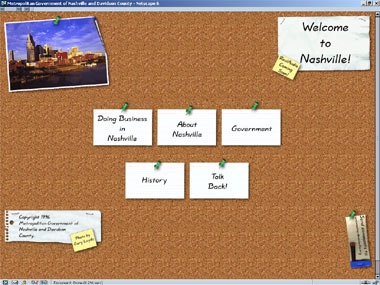
With the next generation of web browsers, visual enhancements were soon enabled via backgrounds and more images. The version was released in late 1995 and was in use until December 1996.
1997 - 1998
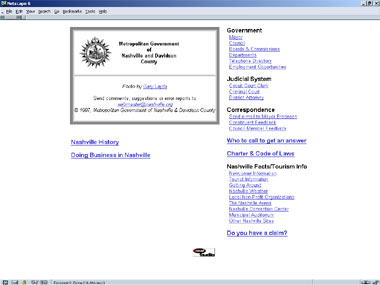
Given a more professional look and feel, this version of the home page was released in January 1997 and used until November 1998. The use of Real Audio was incorporated for the first time.
1998 - 2000
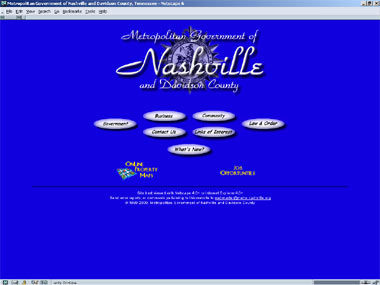
This version was released in December 1998 and used until May of 2000. The main pages had this common look and feel, but departments were allowed to create their own pages and post to the server. Old Perl script reports indicate that the site was receiving about 9,000 visitors per week. The webteam grew to 2 employees in the spring of 1999.
2000 - 2001

Released June 2000 and used until October 2001. The WebTeam continued to be a team of two staff. A newer, much faster Dell server, running MS 2000, replaced the Unix box in October of 2001.
Nashville.gov
2001 - 2007

Released in November 2001. The small WebTeam worked with an outside vendor, Link2Gov, to develop a new unified and consistent look and feel for the entire web site. At launch, the domain was changed from Nashville.org to Nashville.gov. Soon afterwards, the WebTeam grew tremendously and by November 2002, the team consisted of 6 full time web developers, two analysts, and a full time programmer. The site was receiving 35,000 - 40,000 visits per week. For the first time, the Metro Website was using live video, streaming video archives, and online applications. The entire conversion of the 4,000+ pages was 99% complete by November 2002.
2007 - 2012
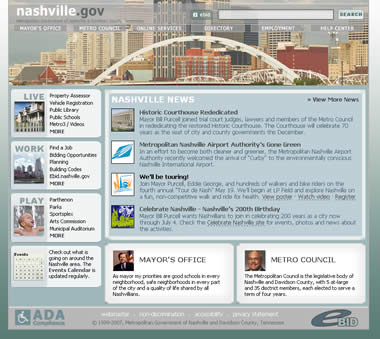
Released on March 30, 2007. This version of Nashville.gov uses the Cascading Style Sheet (CSS) technology almost exclusively to define the look of the web site.
The site was released with a brand new Google search engine to help improve its usability. The team of 6 full-time employees spent 9 months working on the design and page conversion of this version.
By 2010, Nashville.gov entered the world of social media with the addition of links to the official Metropolitan Government Facebook page, followed by linkage to the Metropolitan Government YouTube channel upon which all recorded Metro meetings were posted.
In the fall of 2012, this site received over 300,000 unique visitors per month with 1.2 million page views.
2013 - July 2021
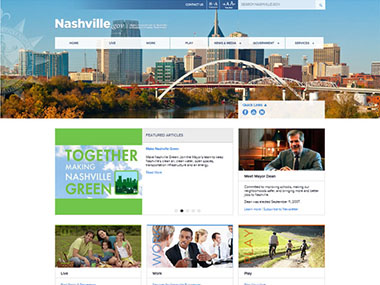
Released on January 11, 2013. This version of Nashville.gov used an open source Content Management System called DotNetNuke as its backbone. The project to migrate all content from the old individual HTML-based pages was a concerted effort of over 200 content owners within Metro departments and agencies who for the first time could update their departmental pages directly.
August 2021 - present

Released on August 2, 2021. This version of Nashville.gov uses an open source Content Management System called Drupal as its backbone. This site takes a services-centric approach to make it easier for Nashville citizens to find the services that Metro Government offers without the need to know what department handles that service. The concept for this site was based on feedback gathered from citizens, businesses, neighborhood groups and Metro departments. The bold new design is clean, open and modern. The search engine was completely redesigned to be faster, offer flexible filtering and give search results suggestions. The site also incorporates a "smart" 404 page that will offer suggestions for content should a user try to access a page that no longer exists or has been moved. This site is also connected more closely with Nashville's hubNashville customer service portal to help customers submit requests. Everything about this new site has been engineered from the start to make it easier for citizens to interact with Metro.
